What the ... ?
I was checking on some tulip poplars I sprayed with a preemergence herbicide about six weeks ago. Why in the world did I spray perfectly beautiful plants with an herbicide? It’s not because I was betting on the herbicide killing the tulip trees and wanting to have the tulip trees I killed “welcome” me at the pearly gates. (I’m sure all the bugs I killed will have the honor.) I did that because I was assessing the crop safety of a new herbicide SePRO is introducing to the green industry. (I’ll chat about this new pre-emergent herbicide in a bit more detail in the July issues.)
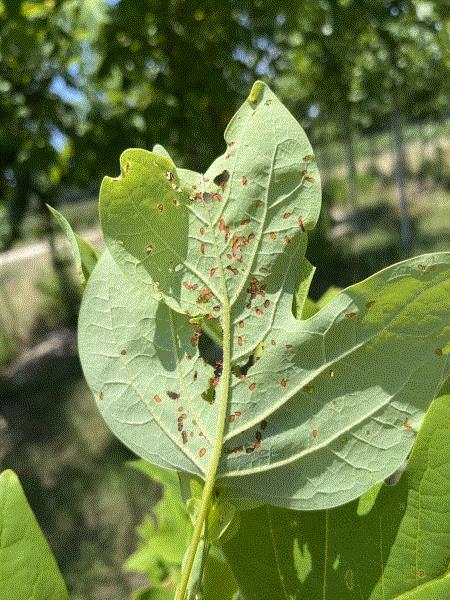
Just about every plant in the field nursery block I used for this experiment sported new necrotic spots or pits on their terminal foliage. This damage wasn’t on the leaves three weeks ago.
What’s causing these spots?
Box Tree Moth Quarantines
USDA’s Animal and Plant Health Inspection Service (APHIS) announced late last month that it has established quarantines for the box tree moth in Massachusetts and Ohio and expanded quarantines in Michigan and New York. Go HERE to read an excerpt of the Federal Order. If you’re looking for punishment, go HERE for the Federal Order in its full glory. (Seriously? You read the full version? Why do you torture yourself??)
The quarantine in Massachusetts is established not just for Barnstable County, where the invasive pest was detected in September 2023. The entire Bay State is now under quarantine. Go HERE for quarantine and compliance agreement information in Massachusetts.
In the Buckeye State, state quarantines were already issued by the Ohio Department of Agriculture in April 2024. Now, federal quarantines are established in all of Butler, Clermont, Hamilton and Warren Counties, and portions of Montgomery County. Go HERE for quarantine information in Ohio.
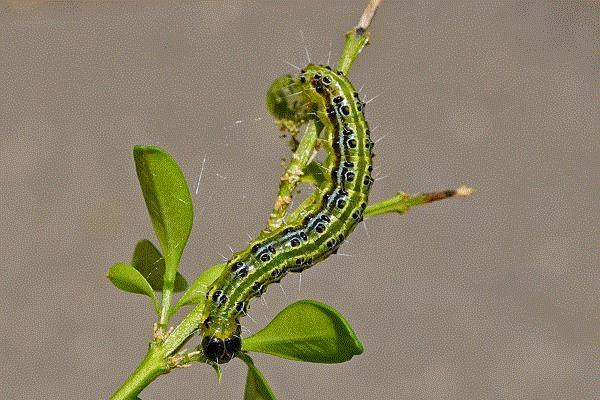
A box tree moth caterpillar. (Photo credit: Joe Boggs, The Ohio State University)
In addition to all of Lenawee and Washtenaw Counties and parts of Jackson and Monroe Counties, federal quarantines in Michigan have now been expanded to include all of Clinton, Eaton, Ingham, Jackson, Livingston, Macomb, Monroe, Oakland, St. Clair and Wayne Counties. Several of these counties were already under state quarantine since December 2023. Go HERE for quarantine and regulatory information in Michigan.
The Empire State is the beachhead of the box tree moth invasion and has the greatest number of counties under quarantine. APHIS now places under quarantine all of Allegany, Broome, Cattaraugus, Cayuga, Chautauqua, Chemung, Chenango, Clinton, Cortland, Franklin, Genesee, Herkimer, Jefferson, Lewis, Livingston, Madison, Monroe, Oneida, Onondaga, Ontario, Oswego, Otsego, Tioga, Tompkins, Saint Lawrence, Schuyler, Seneca, Steuben, Wayne, Wyoming and Yates Counties, in addition to the earlier quarantined areas in Erie, Niagara and Orleans Counties. Go HERE for quarantine information in New York.
The Horticultural Research Institute (HRI) held a timely webinar called, “Box Tree Moth Demystified,” on May 20, 2024. Joe Boggs of The Ohio State University and Alejandro Del-Pozo of Virginia Tech provided a lot of great information on the biology, monitoring and management of box tree moth in this webinar. Go HERE for a recording of the webinar.

APHIS Actions on Imports
USDA APHIS has been busy. In addition to domestic quarantine and regulatory actions on box tree moth (and other pests), APHIS also issued several regulatory decisions on imported plant materials and products.
APHIS updated its Plants for Planting Manual and Agricultural Commodity Import Requirements (ACIR) database and removed 21 European Union (EU) countries and the United Kingdom from the list of countries where citrus longhorned beetle and Asian longhorned beetle are present. Six EU countries remained on the list, however, including Austria, Croatia, Finland, France, Germany and Italy.
APHIS also determined that plant genera that can serve as hosts of citrus longhorned beetle and Asian longhorned beetle are now admissible from Belgium, Demark, the Netherlands and the United Kingdom if these plants have root collar diameter greater than 10 mm or 0.4 inches and satisfy current import permit requirement. Go HERE for APHIS’s announcement about the updates.
In case you’re wondering, the citrus longhorned beetle and the Asian longhorned beetle are important wood boring pests of living ornamental and horticultural trees. If introduced, these pests can cause significant economic damage and regulatory hassles. Active federal quarantines against Asian longhorned beetle are now established in parts of Clermont County (Ohio), Worcester County (Massachusetts), Nassau and Suffolk Counties (New York), and Charleston and Dorchester Counties (South Carolina).
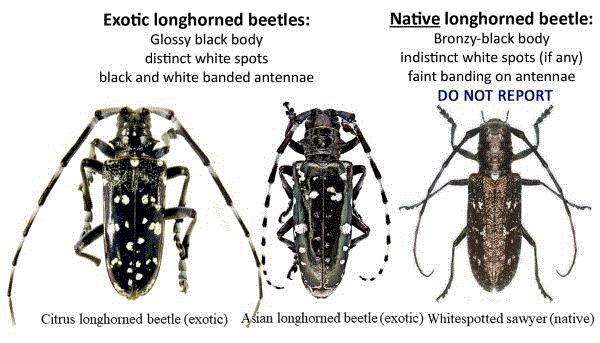
From left to right: citrus longhorned beetle, Asian longhorned beetle, and whitespotted sawyer. (Photo credit: Pest and Disease Image Library; Steven Valley, Oregon Department of Agriculture; Michael Bohne, US Forest Service; from Maine Department of Agriculture, Conservation & Forestry)
Last week, APHIS deregulated tomato brown rugose fruit virus-infested tomatoes and peppers for consumption. This action allows growers to market fruits grown in facilities where the virus is detected, rather than destroying the crops. The decision was based on an August 2023 Pathway Risk Assessment, which concluded that it’s unlikely to introduce the devastating virus to the production areas in the United States via fresh tomato and pepper fruits destined for consumption.
APHIS will, however, continue to maintain a strong regulation on imported and domestic tomato and pepper propagative materials, including seeds and plants intended for planting, to prevent the introduction and spread of tomato brown rugose fruit virus. Go HERE to read APHIS’s announcement on action against the tomato brown rugose fruit virus.

UF Updates Back Pocket Grower
The University of Florida (UF) Extension and FreshLearn have released an updated version of its free website, Back Pocket Grower. The website was designed by Paul Fisher and Maria Kinslow of UF Extension and Bruce McKay of FreshLearn as an easy digital resource for growers. The website is sponsored by industry partners in the Floriculture Research Alliance, the Ken and Deena Altman Online Extension Gift, and UF Extension.
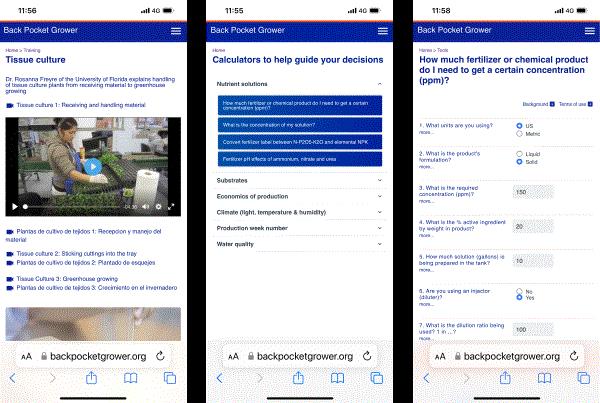
The Back Pocket Grower website and app provide you with training videos and calculators for important tasks, such as this one for mixing fertilizer. (Picture credit: UF)
Y’all can access the resources in the Back Pocket Grower either as a website or a mobile device application. Under the Tools tab, you’ll be able to get calculators for fertilizer, climates, substrates, crop budget, water quality, and production week number. Under the Training tab, you’ll find short videos on how to monitor water quality, propagate cuttings, test for pH and EC, among many more topics.
Go HERE to go to the website and download an app.
You can get training on the Back Pocket Grower website and app by signing up for courses in the UF Greenhouse Training Online program. The next course is Nutrient Management 1 (Introduction), which starts on July 8 and ends on August 2. Go HERE to sign up for the courses.

Answer to “What the … ?”
Mid-June is usually when I see damage from today’s mysterious critter. Y’all are right if you guess yellow poplar weevil, a native insect.
The yellow poplar weevil is also called the tuliptree leafminer, magnolia leafminer and sassafras weevil. Now, if y’all think all entomologists are smart people, I can’t say you’re wrong. But even the best of us have a minor shortcoming—we’re not particularly imaginative when it comes to naming an insect. The common names of the yellow poplar weevil reflect two characteristics. First, it’s a leafminer (thus, continuing my theme on leafminers from the last issue of this newsletter). Second, it feeds on yellow poplar, tulip poplar or tuliptree, as well as deciduous magnolia, sweet bay and sassafras. Now that I think about it, maybe we are super good at naming bugs by reflecting the most defining characteristics plainly and simply.
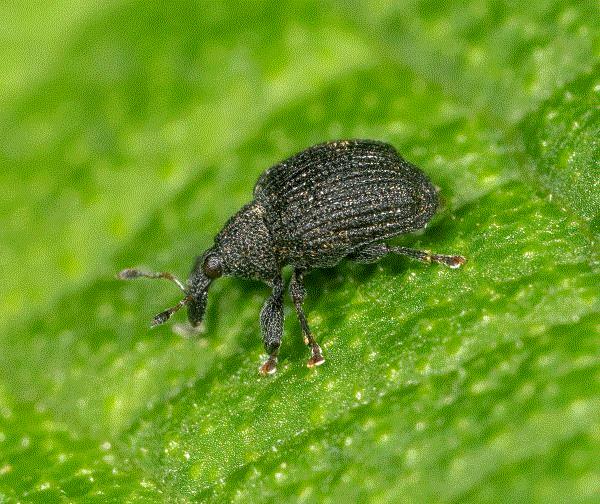
An adult poplar weevil. (Photo credit: Jim Moore, Maryland Biodiversity Project)
The damage in the picture I shared earlier is caused by adults. The small (about 1/8 inch long), black weevils feed on the lower side of the leaves, causing brown pits, necrotic spots or shotholes. The yellow poplar weevil has one generation per year. Adults are active in late May through mid-July.
Adults lay multiple eggs in leaf midribs. The larvae or grubs mine and cause blotch mines on the leaves. Heavily damaged leaves can seem scorched, and these leaves often drop prematurely.
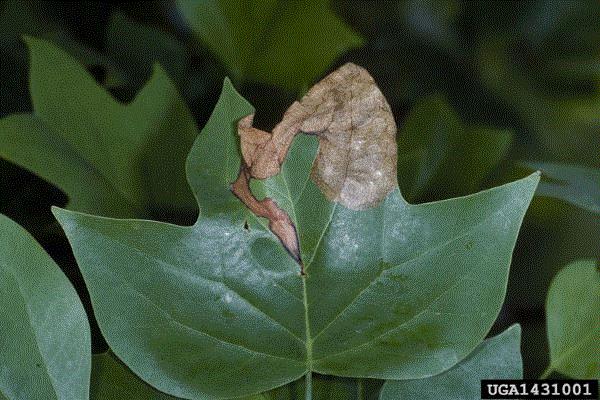
A blotch mine caused by yellow poplar weevil grubs. (Photo credit: Lacy Hyche, Auburn University, Bugwood.org)
I don’t usually recommend management since the damage (necrotic spots, mines and leaf drops) don’t typically affect the long-term health of a tree. Sure, it looks bad, but the damaged leaves will drop, or new leaves will flush and mask the damage.
If you must, the best insecticide application timing is during adult activity. Contact insecticides, such as acephate and carbaryl, are effective. But remember that these insecticides must be sprayed to all the leaves, which can pose a challenge on tall trees. Several Extension publications suggest applying a systemic insecticide, such as imidacloprid, to the soil in the fall to provide protection to the leaves next spring. I haven’t tested this approach so I can’t vouch for its efficacy.




See y'all later!

JC Chong
Technical Development Manager at SePRO
Adjunct Professor at Clemson University
This e-mail received by 27,847 subscribers like you!
If you're interested in advertising on PestTalks contact Kim Brown ASAP!